 Transport immobilization for hip fracture
Transport immobilization for hip fracture
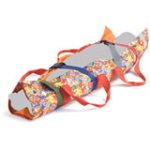 Before we go into detailed instructions, let's recall the basic concepts of this topic.
Before we go into detailed instructions, let's recall the basic concepts of this topic.
Immobilization is the creation of immobility of a damaged (injured) part of the body.
Transport immobilization is a temporary measure, immobilization during the delivery of the victim to a medical institution.
Proper transport immobilization for a hip fracture is essential for the further outcome of this severe injury. Recall that fractures of the femur are divided mainly into 2 types:
- fractures of the proximal femur;
- fractures of the diaphysis of the femur.
Type 1, fractures of the proximal (neck and trochanteric region) of the femur are more common in older people. The cause is usually a sideways fall. In this case, a blow occurs with the area of \u200b\u200bthe greater trochanter, or a sharp turn of the thigh outward or inward.
Signs of a fracture of the femoral neck or trochanteric region are:
- pain in the hip joint;
- change in the shape of the joint;
- limb shortening;
- turning the leg outward;
- inability to actively raise the leg.
The 2nd type, a fracture of the femoral diaphysis , is the most common type of femoral injury. Causes and mechanism of occurrence:
- direct trauma (fall on the outer surface of the thigh, direct blow to the thigh);
- indirect injury (fall from height with landing on straightened legs, screw fracture in skiers).
Most often, hip fractures are accompanied by a significant displacement of bone fragments, due to the contraction of the muscles attached to the thigh.
Signs of a hip fracture:
- pain and pathological mobility at the fracture site;
- change in the configuration of the thigh;
- hip shortening;
- inability to actively raise the leg.
Transport immobilization for hip fracture (immobilization technique)
In case of injuries in any area of the thigh, immobilization is carried out in such a way as to ensure the immobility of 3 (three) joints:
- hip:
- knee;
- ankle.
When assisting with fractures and other injuries of the limbs, anesthesia is prescribed by a doctor to prevent pain shock.
The best standard splint for immobilization in case of damage to the femoral neck and femur is the Dieterichs splint.

Imposition of the Dieterichs tire a - medial bar of the tire; b - lateral plank; in - plantar part of the tire; g - twist; e - fixation of the sole; e - fixing the tire with a belt to the torso and thigh; strengthening the twist after stretching the limb; h — immobilization of the limb with a splint in its final form.
The procedure for applying the Dieterichs bus:
- Splint preparation: spreading the jaws to such a length that the outer half rests with the crutch against the armpit, the inner half against the victim's crotch, and both halves protrude beyond the soles by 10-12 cm.
- Fixation of the achieved position of the jaws with the help of pins: the pin of one half of each jaw is inserted into the corresponding hole of the other half. The halves of the tire are tied together with a bandage at the level of the peg.
- Bandaging a cotton-gauze pad or a thick layer of cotton wool to the inner (medial) surface of both halves of the splint, to the perineal and axillary crutches.
- Covering the ankle joint with a thick layer of cotton wool, followed by bandaging the sole to the foot. In this case, it is important to fix the heel very firmly, otherwise the bandage will slip, and traction behind the foot will not be achieved.
- Passing the inner (medial) and outer (lateral) halves of the tire with the lower ends through the wire staples of the wooden sole with fitting to the side surfaces of the trunk and limb. In this case, it is necessary to additionally wrap the tire with cotton wool in the area of the ankles, knee joint and greater trochanter.
- Laying on the back surface of the immobilized area of a ladder or plastic tire. Purpose: better immobilization, creating some flexion in the knee joint, relaxation of the muscles of the limb.
- Attaching the splint to the body with special straps, a belt, woven material passed through the slots of the upper jaw.
- By carefully pulling on the foot, the limb is stretched until the axis of the damaged surface is corrected. In this case, the transverse crossbars of the branches should rest against the groin and armpit. In this position, the foot is fixed with a twist to the transverse lower crossbar.
- The final fixation of the splint to the body by circular bandage moves. At the level of the torso, thigh and lower leg, fixation should be the strongest. For long-term transportation (evacuation), gypsum rings are used, made from 7-8 layers of gypsum bandage. In total, 5 rings are applied: 2 - on the body and 3 - on the limbs (as in the figure in part "g").
In the absence of Dieterichs tires, it is better to use ladder tires.

Transport immobilization of the lower limb in case of damage to the thigh a - ladder bus assembly; b - tire overlay.
The use of stair splints for a hip fracture (technique):
- The 2 bars are tied together lengthwise by bending the bottom end of one of the bars laterally 20 cm from the edge. An elongated tire will be obtained for application along the outer surface of the damaged limb, as well as along the lateral surface of the body to the armpit.
- 1 splint is prepared for application along the inner surface of the thigh.
- 1 tire is modeled with a recess for the heel, calf muscles, with a footrest and a slight angle of flexion in the knee joint.
Plastic tires are applied in a similar way.
If there are no standard tires, transport immobilization in case of a hip fracture is carried out by improvised means: slats, skis, bunches of brushwood and other objects of sufficient length to immobilize three joints (hip, knee, ankle).
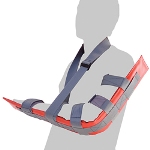

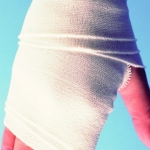
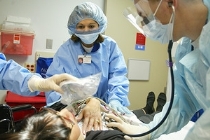

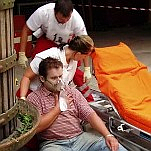
TRANSPORT IMMOBILIZATION IN FRACTURE OF THE BONES OF THE FOREARM (RIGHT), TRANSPORT IMMOBILIZATION IN FRACTURE OF THE HIP - Nursing and Manipulation Technique